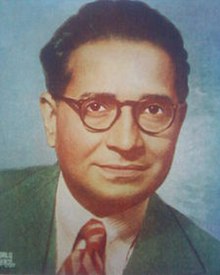K. S. Krishnan
| Kariamanickam Srinivasa Krishnan | |
|---|---|
 |
|
| Born |
December 4, 1898 Watrap, India |
| Died | June 14, 1961 (aged 62) |
| Nationality | Indian |
| Fields | Physics |
| Institutions |
Madras Christian College Indian Association for the Cultivation of Science Dacca University Allahabad University National Physical Laboratory of India |
| Alma mater |
The American College in Madurai Madras Christian College Calcutta University |
| Academic advisors | CV Raman |
| Known for |
Raman effect Crystal Magnetism Magneto Chemistry Technique for measuring Magnetic anisotropy of magnetic crystals |
| Notable awards |
|
Sir Kariamanickam Srinivasa Krishnan, FRS, (4 December 1898 – 14 June 1961) was an Indian physicist. He was a co-discoverer of Raman scattering, for which his mentor C. V. Raman was awarded the 1930 Nobel Prize in Physics.
Kariamanickam Srinivasa Krishnan, Iyengar generally referred to as K. S. Krishnan or KSK, was born on December 4, 1898 in Watrap, Tamil Nadu in a Brahmin family. His father was a farmer-scholar deeply versed in Tamil and Sanskrit literature. He had his early schooling in Hindu Higher Secondary school, Watrap in his native village, after which he attended the American College in Madurai and the Christian College, Madras where after gaining his degree in Physics he became a Teacher in Hindu Higher Sec School in his native village and co-worked with Sir.C.V.Raman in the discovery of scattering of light.
In 1920, Krishnan went to work with C.V. Raman at the Indian Association for the Cultivation of Science, Kolkata (then Calcutta). There he engaged himself in experimental study of the scattering of light in a large number of liquids and its theoretical interpretations. He played a significant role in the discovery of the Raman Effect.
In 1928 he moved to the Dacca University (now in Bangladesh) as the Reader in the physics department where he studied magnetic properties of crystals in relation to their structure. Krishnan, along with other rising scientists such as Santilal (S.) Banerjee, B.C. Guha, and Asutosh Mookerjie developed an elegant and precise experimental technique to measure the magnetic anisotropy of dia — and paramagnetic crystals. Their findings were published by the Royal Society of London in 1933 under the title, Investigations on Magne-Crystallic Action.
In 1933 he returned to Kolkata to take up the post of Mahendralal Sircar Professor of Physics in the Indian Association for the Cultivation of Science where he continued to collaborate fruitfully with Dr. Santilal Banerjee to elaborate on the magnetic properties of crystals in relation to their structure. Their joint papers and communications (published in Nature, Terrestrial Magnetism and Atmospheric Electricity, and by the Royal Society), remain to this day, aside from a number of other pathbreaking contributions they also published in various Physics journals, the most definitive scientific studies on the structure and tendencies of small crystals. Their experiments in Dhaka and continued collaborative research in Kolkata led to what is now known as the Krishnan Banerjee method in measuring the magnetic susceptibility of small crystals.
...
Wikipedia
